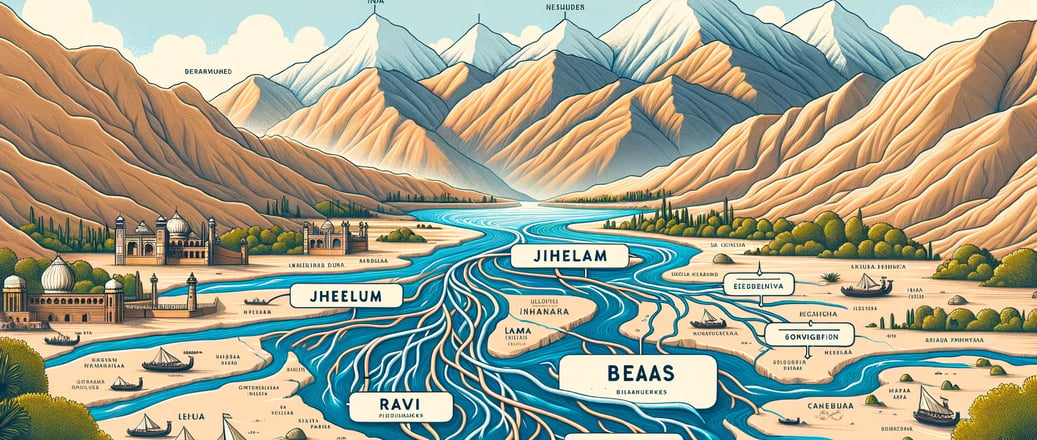The Majestic Indus River System: Lifelines of South Asia:
INDIAN GEOGRAPHY
Purnima Aazad
3/27/20243 min read


In the heart of South Asia, the Indus River system weaves its story across mountains, valleys, and plains, playing a pivotal role in the lives of millions. This intricate network, originating from the Tibetan Plateau, carves its way through diverse landscapes, including parts of China, India, and Pakistan, presenting a remarkable narrative of natural splendour and cultural heritage.
The Mighty Indus River: A Journey from the Tibetan Highlands to the Arabian Sea
The journey of the Indus River begins near the serene Lake Mansarovar in Tibet. As it enters India, it graces the Ladakh region of Jammu and Kashmir, creating picturesque landscapes that are nothing short of a traveler's paradise. The river's path through Leh and Ladakh before making its way to Pakistan is a testament to its enduring presence in the region. The Indus is one of Asia's longest rivers, covering a distance of approximately 2900 km and draining an area of about 1,165,000 square km. It's a lifeline, essential for irrigation and agriculture, providing sustenance to the vast regions it traverses.
Geographical Significance
Origins and Path: The system originates from the Tibetan plateau near Lake Mansarovar, marking an important geographical feature. Its journey through different terrains, including the arid deserts and fertile plains, provides insights into the river's impact on diverse ecological zones.
Tributaries: Key tributaries include the Jhelum, Chenab, Ravi, and Beas. Each river has unique origins and courses, significantly contributing to the region’s agriculture and hydrology. Knowing the specifics of these tributaries helps in understanding the regional water distribution and management strategies.
Each tributary of the Indus tells a unique story:
Jhelum River: Emerging from the Verinag Spring in the idyllic Kashmir Valley, this river flows through historical landscapes before joining the Indus in Pakistan. The Jhelum is known for its scenic beauty and strategic importance, and dams like the Mangla Dam mark it.
Chenab River: Birthed from the Chandra and Bhaga Rivers union near Himachal Pradesh's Rohtang Pass, the Chenab weaves through various regions before merging with the Indus. It's celebrated not just for its hydrological contributions but also for its place in folklore and poetry.
Ravi River: Originating near the Rohtang Pass, this river outlines the India-Pakistan border, embodying a natural boundary before joining the Chenab. Despite its smaller size, the Ravi is crucial for irrigating the fertile lands of Punjab.
Beas River: With origins from Beas Kund in the Himalayas, this river's journey through Himachal Pradesh's Kullu Valley to the Punjab plains is emblematic of its nurturing role in agriculture, especially in the region's breadbasket.
The Indus and its tributaries are not merely water bodies but the cradles of ancient civilizations, shaping cultures and sustaining lives for centuries. Their significance extends beyond mere geography — they are central to agriculture, hydroelectric power generation, and the region's ecology. However, managing these water resources is a complex challenge, especially given India and Pakistan's geopolitical nuances.
Economic Importance
The Indus basin is crucial for agriculture, especially in Pakistan and parts of India, where it supports a vast irrigation network. This highlights the river's role in supporting livelihoods and contributing to the agricultural economy.
Hydroelectric power projects along the Indus and its tributaries illustrate the river's contribution to the energy sector, showcasing the integration of natural resources in meeting energy demands.
Historical and Cultural Context
The Indus Valley Civilization, one of the oldest, underscores the river's importance in supporting human settlement and urbanization. This civilisation's archaeological and historical insights contribute to our understanding of ancient cultures and lifestyles.
Literature and folklore associated with the Indus paint a picture of rivers' cultural and spiritual significance in human life, offering a reflective perspective on natural resources.
Environmental and Ecological Aspects
The river system supports diverse ecosystems, from high-altitude cold deserts to fertile plains. Understanding these ecosystems helps us appreciate biodiversity and the importance of conservation efforts.
Environmental challenges such as pollution, habitat destruction, and the impacts of climate change on the Indus basin are crucial topics. These highlight the importance of sustainable water resource management and environmental stewardship.
International Relations and Water Politics
The strategic significance of the Indus waters in regional politics, especially between India and Pakistan, showcases the complexities of international water treaties and conflicts. Knowledge of the Indus Water Treaty and current disputes provides insights into diplomacy, international law, and conflict resolution.
Towards Sustainable Harmony
As we delve into the wonders of the Indus River system, we must recognize the importance of sustainable water resource management. Collaboration, conservation, and equitable sharing are vital to ensuring that this ancient lifeline continues to thrive and support future generations.
The Indus River system, with its majestic rivers and scenic beauty, is a testament to nature's marvels and the intertwined destinies of the regions it flows through. As we reflect on its historical significance and current challenges, let's commit to preserving this natural heritage for a harmonious and prosperous future.
